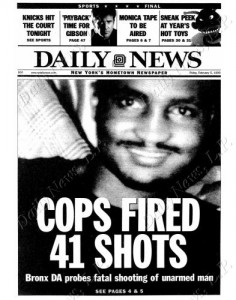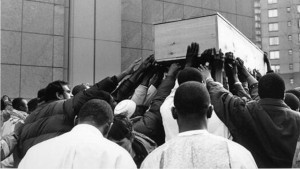On February 4, 1999, four NYPD officers gunned down Amadou Diallo, a 22-year-old Guinean immigrant, just outside his apartment complex in the Bronx. Diallo was shot at 41 times; 19 bullets struck him directly. The four officers-Sean Carroll, Richard Murphy, Kenneth Boss, and Edward McMellon–were charged with second-degree murder and acquitted.
The events surrounding Diallo’s death incited outrage in the community, for it raised already boiling concerns regarding police brutality, racial profiling, and the criminalization of black men. That night, the officers began to trail Diallo, who was then approaching his home, believing that he matched the description of an at-large rapist. After the police identified themselves, Diallo began to run towards his home, and reportedly withdrew his wallet from his jacket pocket. Then, the four officers, at Carroll’s signal, opened fire, supposedly mistaking Diallo’s wallet for a gun. Despite the officer’s fatal assumptions, Diallo was innocent and unarmed. He had no previous criminal record.

In many ways, the shooting of Amadou Diallo harks back to the brutal beating of Rodney King. A couple details of King and Diallo’s cases are strikingly and hauntingly similar. Like with King, the violation of Diallo’s person, and subsequent snatching of his life, resultedfrom unfair suspicion and racial bias. Also, both trials were moved to cities outside the one in which the crimes took place. In both cases, this was decided under the guise that saturated publicity proved unconducive to a fair trial. Both changes of venue were to more suburban, affluent areas (in Diallo’s case, Albany, NY, and in King’s, Simi Valley), areas from which the jury members were drawn. These details, among countless others, comprise a complex, tightly woven thread linking the majority cases of police brutality that both predate the 90s and extend into the 21st-century.
Diallo’s death also preludes many of the incidents of police brutality and racial profiling in minority communities today. It is eerily coincidental that this shooting took place at the end of the 90s and kick-started a series of conversations and policies addressing boiling concerns of police brutality, racial profiling, and the criminalization of black men. Many people, from constituents to politicians, urged law enforcement to examine police training policies that informed racial bias by their very design. At the time, outrage was expressed, notably from Diallo’s mom, Kadi Diallo, over depictions of her son via mainstream media. The sweet, peaceful family man and budding business owner, as family and friends alike knew him, had been reduced to an “African street peddler.” Similar methods of character assassination and distortion are evident in the cases of Trayvon Martin, Michael Brown,and Tamir Rice–sadly, among many, many other unarmed black boys, men, women, and girls senselessly killed by police.

With regards to policy, Diallo’s death, as well as an incident where Ol’ Dirty Bastard of Wu-Tang Clan was fired at by cops who supposedly mistook his phone for a gun, led to the disbandment of the Street Crime Unit in 2002. Unfortunately, police officers no longer need to be disguised to unnecessarily apprehend black women and men. And sadly, these same killings are occurring in 2015 at a seemingly exacerbated rate.
Diallo’s death resulted in an impressive outpouring of artistic tributes and responses. Dwayne Rodgers, an independent artist living in Brooklyn at the time, took the widely circulated photo of Diallo’s casket during the funeral procession. At the time, he was also working on a photo series addressing incidents of police brutality. Musically, from Wyclef Jean’s “Diallo” to Lauryn Hill’s “I Find it Hard to Say (Rebel) to Erykah Badu’s “A.D. 2000”, many artists expressed both intense rage and gut-wrenching grief over Diallo’s senseless death. With the prevalence of social media today, responses to police brutality come from every corner of the world. Musically, there are responses (e.g. Kendrick Lamar’s “Alright”), but many have also taken to the internet to purge their personal grief, sadness, and anger, and to rally around movements with goals of eradicating police brutality (e.g. Black Lives Matter). —Keith Freeman
Works Cited
[The title of the entry is a spin on the title of Beth Roy’s book, 41 Shots…and Counting: What Amadou Diallo’s Story Teaches Us About Policing, Race, and Justice.]
Naomi. “The Amadou Diallo Shooting.” Online video clip. YouTube. Youtube, 22 Apr. 2006. Web. 12 November 2015.
Susman, Tina. “Before Ferguson: Deaths of other black men at hands of police.” Los Angeles Times. 13 August 2014. Web. 12 November 2015.
